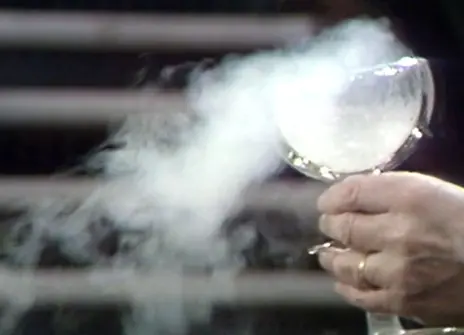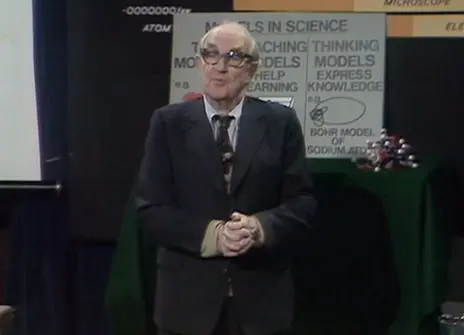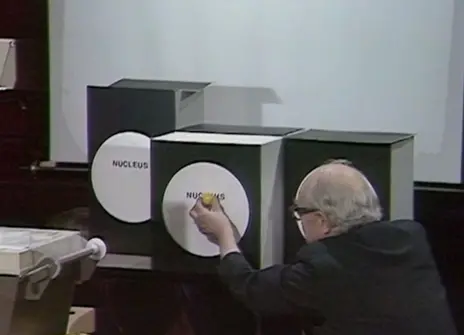Lecture 2 – Molecules in motion
From the 1979 lecture programme:
How does air exert its pressure? What does that pressure suggest concerning air molecules? See the effect of air molecules bombarding tiny visible victims. We shall measure the spacing of molecules in air; also estimate their speed. See liquid air and argue some evidence from it. How does jet propulsion work? Hot exhaust gases blast out backwards as their molecules rebound from internal walls which they push forwards.
About the 1979 CHRISTMAS LECTURES
From the 1979 lecture programme:
We build our scientific knowledge by doing experiments, by asking questions of Nature and sorting out the answers that Nature gives us. The sorting-out often involves reasoning and imagination; but without trying experiments to see what does happen we should just be guessing in the dark.
The earliest scientists, who helped our ancestors long ago to make a calendar, to navigate, and to measure and build, gathered some knowledge by watching what does happen. Nature was offering experimental knowledge all round them; and they observed and extracted general knowledge and used it. That was knowledge of man-sized things: a hand mirror to reflect rays of sunlight; the star patterns seen at night reduced to a sketch; a seesaw to balance children —leading to weighing machines; a bridge across a stream, leading to knowledge of forces; measurements for a building only a few men high; a survey of a mountain that men could climb.
Such gathering and use of scientific knowledge dates from thousands of years ago, perhaps even a million or so. That was experimental knowledge, though it was sometimes mixed with guessing or even wild imagining. But when men tried to describe the fire of the stars far out of reach, or to imagine outrageously small moving atoms in all matter, they were indeed guessing in the dark about things far above or below the scale of man-sized things.
Some early scientists did make interesting guesses about atoms, yet these were only guesses. These were clever philosophy if you like, but there were no experiments to support them.
Except for clever suggestions, our knowledge of atoms is very young compared with our older scientific knowledge. Some of it is a few centuries old but much of it is only one century old at most. There are two reasons for that late development. First: since atoms are (as we now know) far too small to be seen, all our experimental gathering of knowledge has to be indirect. Although we now know a great deal about atoms, and about the still smaller parts of atoms, we still have to describe them by imaginative pictures which we call models.
Second: even to build such knowledge indirectly, new apparatus had to be developed, such as vacuum pumps and electronic supplies for high voltage. The aid of a vast new technology was needed.
Nowadays when one learns what has been discovered about atoms one has to learn by hearsay, one has to accept the indirect methods and swallow the picturing by imaginative models. Then a keen listener must long for some experimental support or illustrations. That is what these lectures will offer in their 'circus of experiments'. The circus cannot cover all our new knowledge of atoms but it will, we trust, give visitors a feeling of friendly first-hand acquaintance, a contribution of confidence and understanding as well as a delight in seeing experiments.






